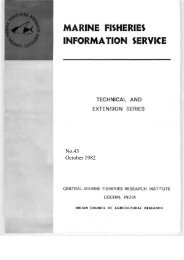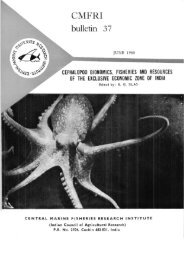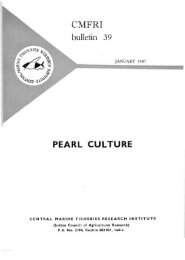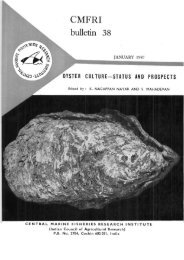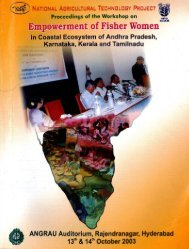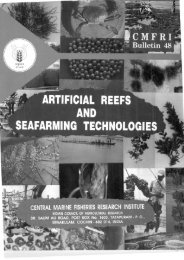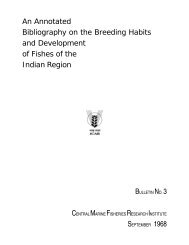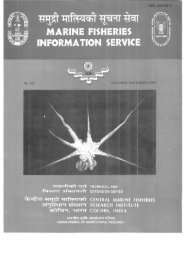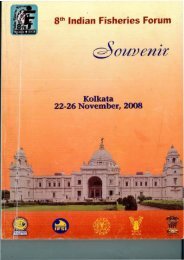Marine Fisheries Information Service - Eprints@CMFRI - Central ...
Marine Fisheries Information Service - Eprints@CMFRI - Central ...
Marine Fisheries Information Service - Eprints@CMFRI - Central ...
You also want an ePaper? Increase the reach of your titles
YUMPU automatically turns print PDFs into web optimized ePapers that Google loves.
<strong>Marine</strong> <strong>Fisheries</strong> of Andhra Pradesh-An Appraisal<br />
3<br />
several folds in the coming years. In the demersal<br />
group, croakers formed the dominant group (4.5%)<br />
followed by perches (3.7%), silverbellies, catfish and<br />
rays (2.2% each). Crustaceans were dominanted by<br />
the penaeid prawns (9.9%) followed by crabs (2.8%)<br />
and non-penaeid prawns (1.4%). Prawns have always<br />
been the mainstay of the Andhra marine fishery and<br />
are the major revenue earner for the state. Of late<br />
however, the catch of pelagic fishes like sardine and<br />
mackerel have increased but prawns still continue to<br />
be major revenue earner in the marine fisheries<br />
sector. The contribution of the important resources<br />
to the total fish catch (all gears combined) of Andhra<br />
Pradesh during 2000 to 2006 is given in Fig.6. Among<br />
these, the catch of pelagic fishes viz., sardines,<br />
mackerel and ribbonfish exhibited high annual<br />
fluctuations compared to the demersal resources.<br />
Others<br />
1%<br />
Crustaceans<br />
14%<br />
Fishes<br />
85%<br />
Fig. 5. Contribution of major groups to the marine<br />
fishery of Andhra Pradesh<br />
However, the increased landings of all major<br />
resources resulted in better annual catch during 2006<br />
(Fig.3).<br />
Mode of exploitation<br />
The crafts used for fishing include the large and<br />
medium mechanized trawlers (Plate 1) and a number<br />
of traditional crafts viz. catamaran (tepalu), masula<br />
boat and the nava (Plate 2). Technological<br />
advancement in craft construction include the<br />
introduction of steel bodies for larger crafts and<br />
fibregalss slowly replacing the wood in the smaller<br />
traditional crafts. The details of different crafts<br />
operating along Andhra Pradesh have been<br />
discussed in detail by Sreekrishna (2002). A variety<br />
of gears are employed to harvest the rich coastal as<br />
well as offshore marine fishery resources of the state.<br />
The gears in use range from simple cast nets to large<br />
seines and trawls. The line fishing for coastal, offshore<br />
and oceanic fishes is very active in Andhra Pradesh.<br />
They are operated either from small traditional nonmecahnized<br />
crafts, motorized crafts or from medium<br />
to large mechanized crafts depending on the area of<br />
operation, resource targeted and price of the fish.<br />
During 2001-06, the mechanized, motorized and nonmechanized<br />
sectors contributed on an average, 42.1,<br />
23.3 and 34.6% respectively to the total marine fish<br />
landings of the state (Fig.7). While the mechanized<br />
sector showed an increasing trend, non-mechanized<br />
sector registered a declining trend. The trend by<br />
motorized sector remained more or less the same<br />
over the years. Motorization is slowly becoming<br />
popular and more and more non-mechanized units<br />
Sardines<br />
Ribbonfish<br />
Mackerel<br />
Carangids<br />
Penaeid prawns<br />
Elasmobranchs<br />
Croakers<br />
catch in tonnes<br />
Percent<br />
Mechanized<br />
Motorized<br />
Non-mechanized<br />
Year<br />
Fig. 6. Major resources contributing to the fishery<br />
of Andhra Pradesh<br />
Year<br />
Fig. 7. Contribution of different sectors to the fishery and<br />
their trends during 2000-2006




